Air of Authority - A History of RAF Organisation
No 541 - 598 Squadron Histories
Numbers in the 500 series were originally allocated to squadrons of the Special Reserve but only five such squadrons had been formed before they were absorbed into the Auxiliary Air Force. As more squadrons were required by the wartime expansion of the RAF, numbers in this series began to be formed as the 300 and 400 series were allocated to Foreign and Commonwealth units.
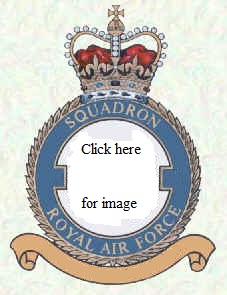 Formed
from B & F Flights of the Photographic Reconnaissance Unit at Benson on 19
October 1942.
Formed
from B & F Flights of the Photographic Reconnaissance Unit at Benson on 19
October 1942.
Equipped with Spitfires, it operated over Europe throughout the rest of the war, although some Mustangs were received and operated alongside the Spitfires from June 1944.
After the war it was intended to send the a detachment of the squadron to Africa for survey work, for which it received some Lancasters. However, this plan was cancelled and the squadron disbanded at Benson on 1 October 1946, the Lancaster element forming the nucleus of a reformed No 82 Squadron. During this period the squadron was engaged in photographing the UK for mapping purposes and to assist various planning authorities with their post-war planning.
The squadron reformed at Benson on 1 November 1947, again in the PR role, equipped with Spitfire XIXs, which were replaced by Meteor PR 10s in December 1950. The squadron moved to Germany in June 1951 joining 2 TAF, initially at Buckeburg and later Gutersloh and Laarbruch until Nov 1955, when it moved to Wunstorf, where it disbanded on 6 September 1957.
.
Squadron Codes used: -
| ES | Oct 1945 - Dec 1946 |
| WY | Nov 1947 - 1951 |
| A | 1951 - 1954 |
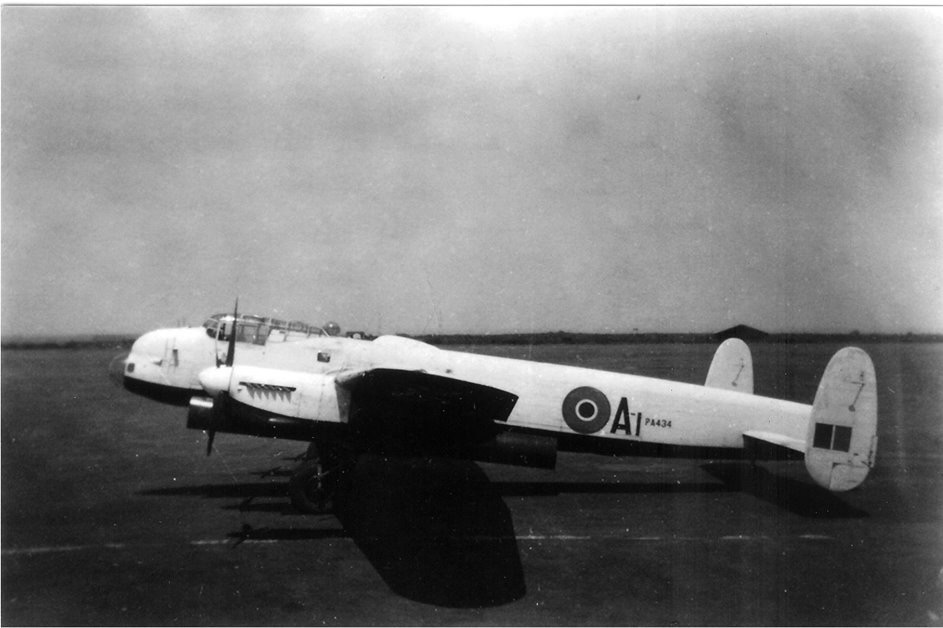 |
 |
| Lancaster, PA434 of No 541 Sqn
in West Africa 1946 Photos courtesy of Anthony Coyle from the collection of his father, John Coyle, who was a Flight Engineer on the unit |
|
The photographs of No 541 shown below are courtesy of John Archer (click on the image for an enlargement)
The photographs of No 541 shown below are courtesy of Sqn Ldr David Pownall (click on the image for an enlargement)
 |
 |
 |
|
Two Meteor 10s at Juba (Southern Sudan) on 1st April 1955, en route to Mombassa. Flown by Fg Offs Denny Beard and Dave Pownall. |
Squadron Aircrew before detachment to Wildenrath for Exercise Coronet. July 1953. Left to Right: Sgt ? Waugh, Fg. Offs Dave Pownall & Tom Benson, Wg Cdr J H L Blount, Fg Offs Gerry Mayer, Dickie Littlejohn, Brian Dove-Dixon & Derek Webb. |
Detachment to Vearnes (Norway) September 1954. Flt Lt Toby Meyer, Fg Offs Tom Benson and Dave Pownall with American aircrew and Norwegian Officers. |
 |
 |
|
| Practice formation over Germany | A section of Squadron Tie. The colours are meant to be Grey and Maroon. |
The photograph shown below is courtesy of Ruud Scholten, Webmaster British War Cemetery Brunssum (click on the image for an enlargement)
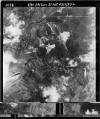 |
|
Aerial photo taken by No 541 Sqn on 31 August 1943 of the city of Brunssum in South-Limburg In The Netherlands |
[Aircraft & Markings | Commanding Officers]
 Formed from A &
E Flights of the Photographic Reconnaissance Unit at Benson on 19 October 1942.
Formed from A &
E Flights of the Photographic Reconnaissance Unit at Benson on 19 October 1942.
Equipped with Spitfires, it operated from nearby Mount Farm conducting reconnaissance sorties over Europe throughout the rest of the war, disbanding on 27 August 1945.
The squadron reformed at Wyton on 17 May 1954, again in the PR role, but now equipped with Canberra PR 7s. The nuclear tests carried out in Australia in 1956/57, required a number of specialised units and it was in order to carry out survey and sampling duties for these tests, that No 542 took on the role. Officially the squadron disbanded on 1 October 1955 and was reformed to take part in the nuclear tests from 1323 Flight on 1 November 1955. However, personnel serving at the time do not remember this, as they continued to serve on the squadron throughout this period at Kinloss, whilst 1323 was actually stationed at Goose Bay in Canada.
The squadron moved to Westonzoyland in December from where it moved to RAAF Laverton until April 1957, when it returned to the UK, although a detachment remained in Australia until some time in 1958. It operated B2 Canberras in the 'filtering' role and B6 Canberras as 'bottlers' and the squadron operated in these roles for a number of months before 1323 Flight arrived in Australia. However, the squadron was formally disbanded by being re-numbered No 21 Squadron on 1 October 1958, a change not recognised by its personnel.
 |
 |
| No 542 Sqn at
Gibraltar (click on photos to see enlargement) Photos courtesy -John Rogers |
|
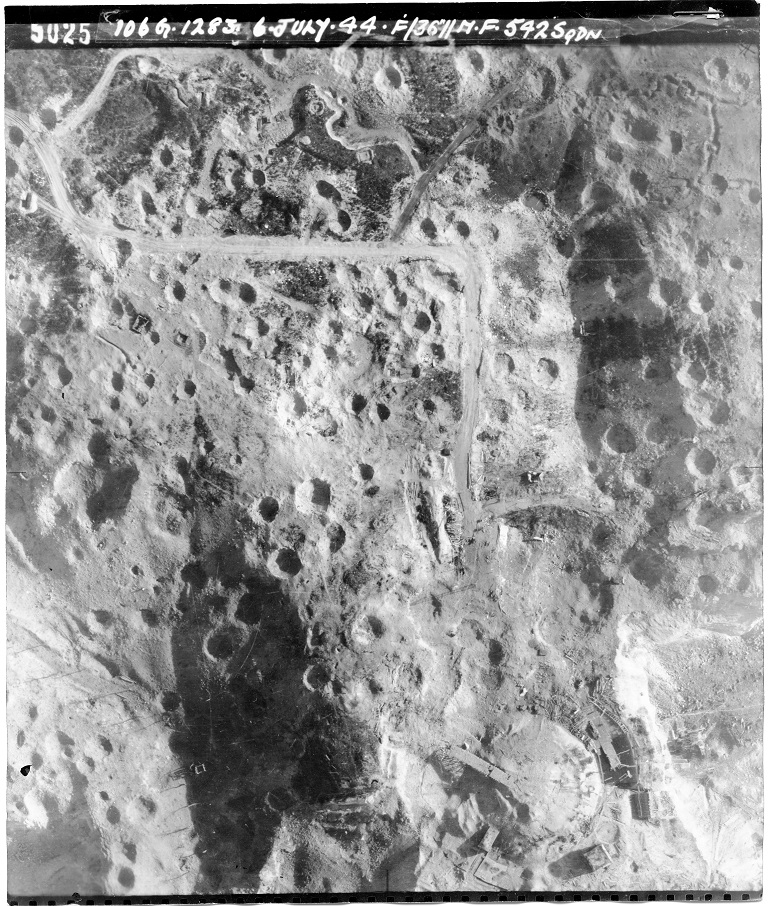 |
'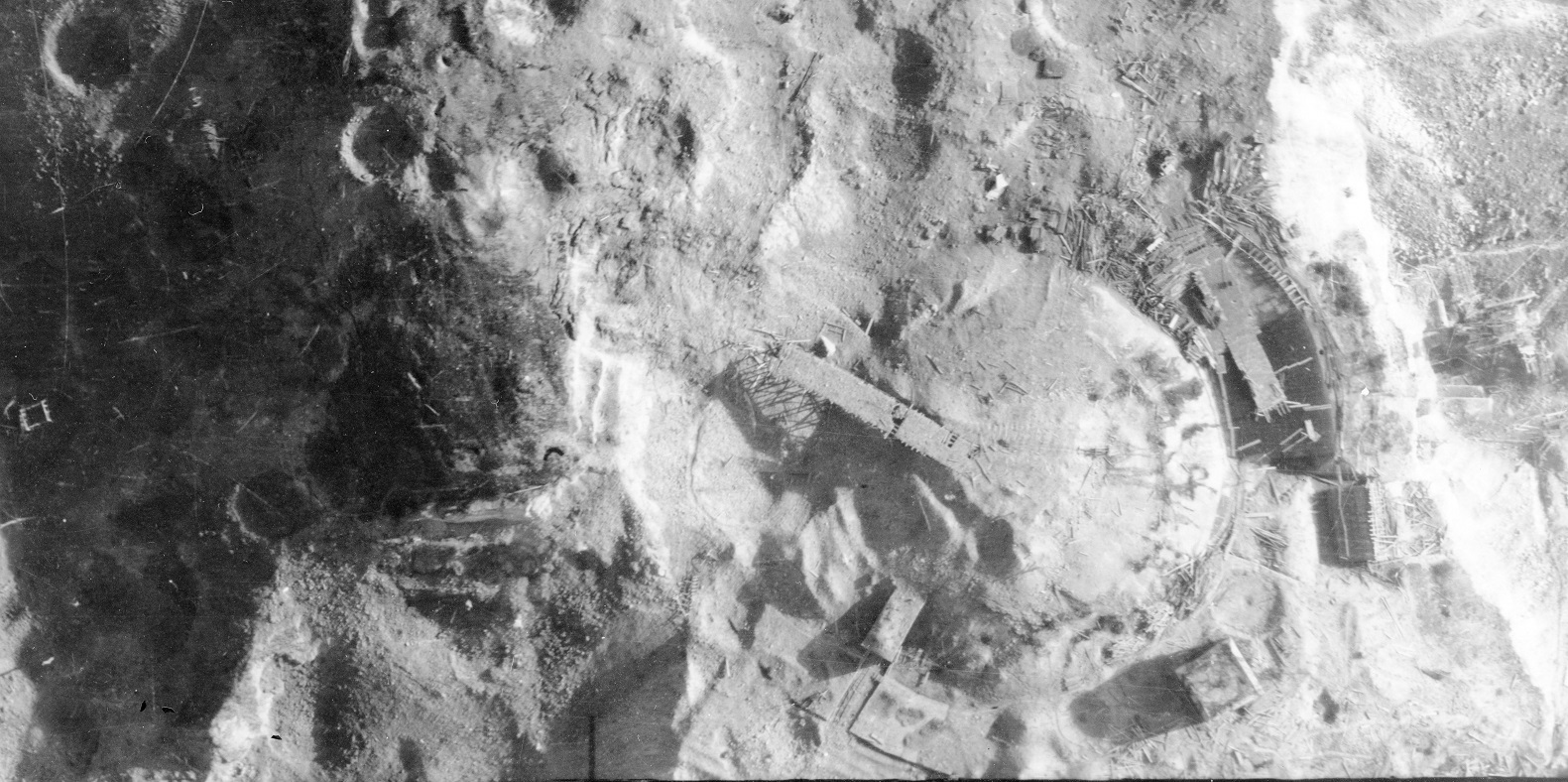 |
|
These photos were taken on 6th July 1944 by No 542 Sqn and show Wizernes
V2 base in northern France (now known as 'La Coupole') after another
heavy bombing by the RAF. The lower image shows the dome in more
detail. Photos courtesy - Stephen Mitchell |
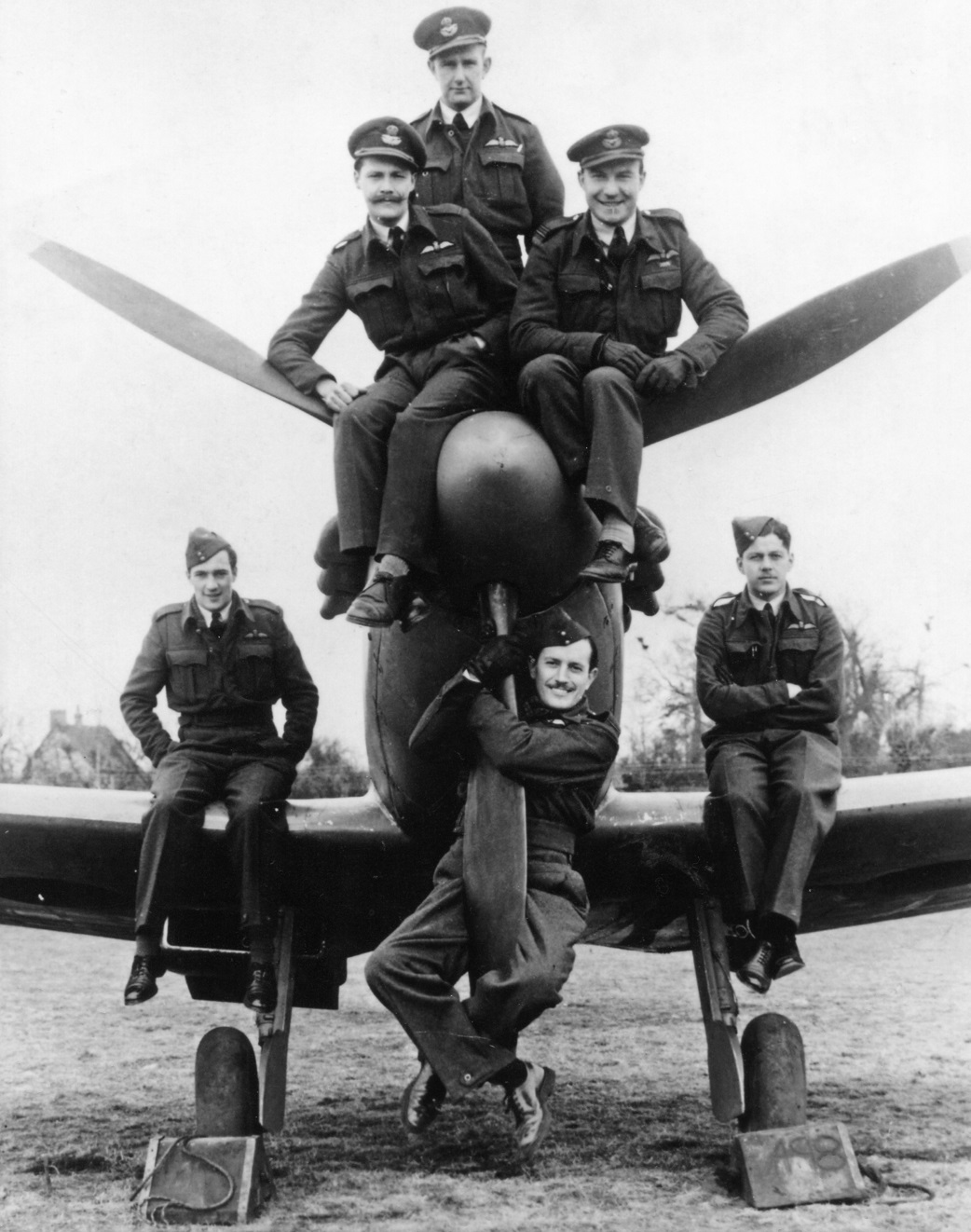 |
| Pilots of No 542 Squadron
top Fg Off McMaster, LtoR Plt Off Whitaker, Flt Lt Whitehead. bottom. Flt Sgt Hunter, Plt Off Grubb Plt Off Singlehurst |
|
|
Squadron Leader D Salway DFC, Officer Commanding No 542 Squadron, October 1942 - June 1943 Photos courtesy - Michael Prendergast and RAF Benson's Ethos and Heritage Facility |
[Aircraft & Markings | Commanding Officers]
No 542 Squadron Association: - e-mail: Turbo542@aol.com
 Another
PR squadron, it was formed on 19 October 1942 at Benson equipped with Spitfires,
initially IVs and Vs and from September 1943, Mk XIs.
Another
PR squadron, it was formed on 19 October 1942 at Benson equipped with Spitfires,
initially IVs and Vs and from September 1943, Mk XIs.
One of its missions in 1943 was to take photos of the results of the Dams raid by No 617 Squadron on 16 May. It also carried the pre and post mission sorties against the Tirpitz, when attempts were made to sink the vessel using midget submarines and it also operated from Russia. However, on 18 October 1943 it was disbanded when 'A' Flight was merged into No 541 Squadron and 'B' Flight became the nucleus of No 309 Ferry Training Unit.
It was reformed on 1 July 1955 as a Strategic Reconnaissance unit at Gaydon equipped with the Valiant B(PR)K Mk 1. In November 1955, it moved to Wyton where the Valiants were replaced by Victors in 1965, after the former were withdrawn from service following the discovery of fatigue cracks in their main spars. In 1957 a three aircraft detachment operated from Edinburgh Field in Australia where they took photographs of the nuclear tests at Maralinga. Except for a short detachment at Honington between March and October 1970, the squadron remained at Wyton until it disbanded on 24 May 1974.
.
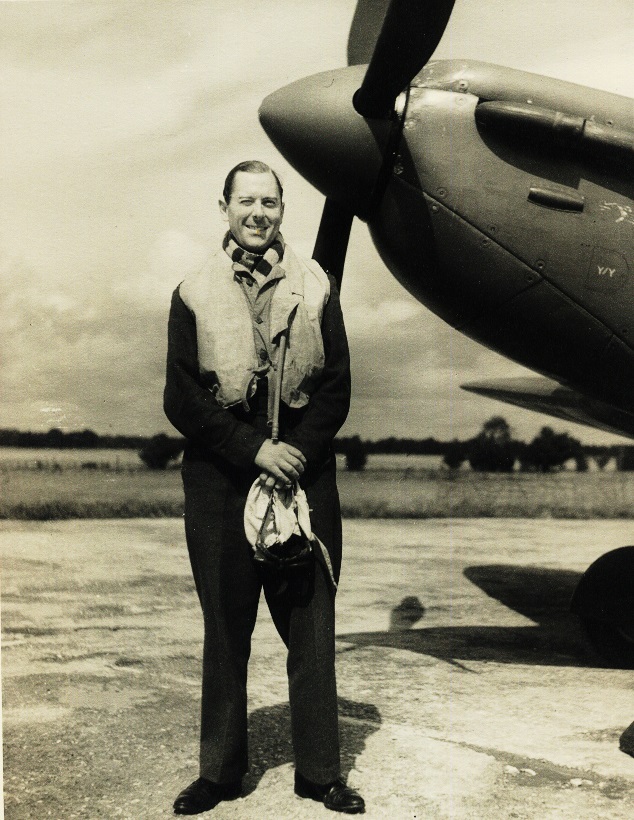 |
| Squadron Leader A E Hill, DSO, DFC
& Bar, 1st Officer Commanding No 542 Squadron, October 1942
Photo courtesy - Michael Prendergast and RAF Benson's Ethos and Heritage Facility |
[Aircraft & Markings | Commanding Officers]
 Formed
at the same time as No's 540 - 543, 19 October 1942, also at Benson, it operated
a variety of types including Spitfires, Wellingtons and Ansons.
Formed
at the same time as No's 540 - 543, 19 October 1942, also at Benson, it operated
a variety of types including Spitfires, Wellingtons and Ansons.
The Wellingtons were used to experiment with night photography, whilst the Spitfires operated from Gibraltar. Mosquitoes were received in March 1943 and these became the squadron's only type in October 1943, when the Spitfires in Gibraltar were transferred to No 541 Squadron.
By the end of the war it was operating the latest marks of Mosquito, the PR 32 and 34 and in February 1945 formed part of the courier service for the Yalta conference. It also carried out survey work before disbanding at Benson on 13 October 1945.
.
.
|
|
| Squadron Leader W R Acott, 1st Officer Commanding No 544 Squadron, October 1942 - July 1943 (shown when he was a Flying Officer) |
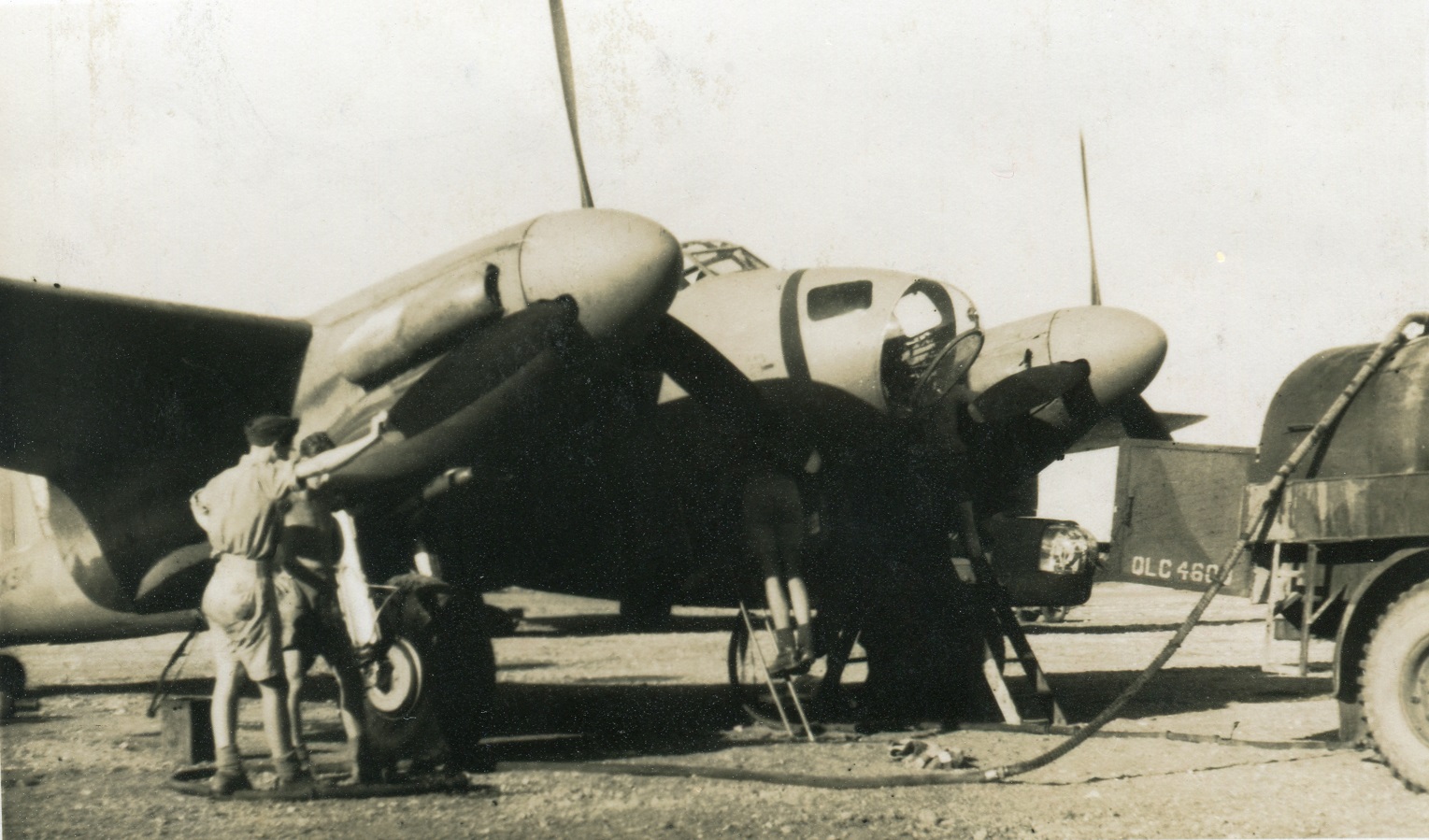 |
| A Mosquito of No 544 Squadron in Gibraltar Photos courtesy - Michael Prendergast and RAF Benson's Ethos and Heritage Facility |
[Aircraft & Markings | Commanding Officers]
 This
squadron was formed in Coastal Command at Holmsley South on 21 October 1942.
It was equipped with Wellingtons and was intended to operate in the
anti-shipping role using both bombs and torpedoes.
This
squadron was formed in Coastal Command at Holmsley South on 21 October 1942.
It was equipped with Wellingtons and was intended to operate in the
anti-shipping role using both bombs and torpedoes.
However in May 1943, it converted to the anti-submarine role by which time it was based at Davidstow Moor. A move to Thorney Island in October also brought re-equipment with Liberators, which it operated over the Bay of Biscay.
A further move occurred in September 1944, this time to Leuchars in Scotland, where it conducted anti-submarine patrols and anti-shipping strikes of the Scandinavian coast. It finally disbanded on 4 June 1945.
.
.
Squadron Codes used: -
| 2V | Aug 1943 - Jun 1945 |
[Aircraft & Markings | Commanding Officers]
Owing to the Kittyhawk being considered unsuitable for the fighter interception role, it was decided to send an RAF squadron to Australia in 1942, this being No 54. However, on 15 December 1943, two more RAF squadrons were formed in Australia, these being No's 548 and 549.
No 548 was formed in Queensland at Lawton, but it was April 1944 before its Spitfire VIIIs arrived.
However, by this stage of the war the threat to Australia from the Japanese an reduced considerably and except for two fighter sweeps carried out by the squadron, its life was very uneventful and it disbanded at Darwin on 9 October 1945.
No Badge Authorised
Squadron Codes used: -
| TS | Dec 1944 - Oct 1945 |
[Aircraft & Markings | Commanding Officers]
Formed at the same time as No 548 on 15 December 1943 but at Strathpine, it received Spitfire VIIIs in April 1944, which it flew throughout its career.
Tasked with fighter interception duties over Northern Australia, it lead a fairly uneventful life as the Japanese threat at that stage of the war had diminished considerably. It finally disbanded at Darwin on 9 October 1945.
No Badge Authorised
Squadron Codes used: -
| ZF | Dec 1943 - Oct 1945 |
[Aircraft & Markings | Commanding Officers]
 Equipped
with Lancasters throughout its career, it was formed from 'C' Flight of No 100
Squadron at Waltham (Grimsby) on 25 November 1943. It formed within No 1 Group, taking part in operations
as part of Bomber Command's Main Force, moving to North Killingholme on 3
June 1944.
Equipped
with Lancasters throughout its career, it was formed from 'C' Flight of No 100
Squadron at Waltham (Grimsby) on 25 November 1943. It formed within No 1 Group, taking part in operations
as part of Bomber Command's Main Force, moving to North Killingholme on 3
June 1944.
Along with most other squadrons, it carried out its last bombing mission on 25 April 1945, after which it conducted supply dropping missions to the Dutch population, repatriated POWs from Germany, and returned soldiers from Italy. It finally disbanded on 31 October 1945.
.
.
.
Squadron Codes used: -
| BQ | Nov 1943 - Oct 1945 |
[Aircraft & Markings | Commanding Officers]
550 - 565 Reserve Squadrons
During 1942 it was decided to create 'Reserve' squadrons from the resources at various Operational Training Units. Each squadron was numbered by having 500 added to the OTU number. Planned squadrons, associated OTUs and aircraft types are shown in the table below: -
| 550 Squadron | AFDU | Spitfire |
| 551 Squadron | 51 OTU | Spitfire |
| 552 Squadron | 52 OTU | Spitfire |
| 553 Squadron | 53 OTU | Spitfire |
| 554 Squadron | 54 OTU | Spitfire |
| 555 Squadron | 55 OTU | Hurricane |
| 556 Squadron | 56 OTU | Hurricane |
| 557 Squadron | 57 OTU | Spitfire |
| 558 Squadron | 58 OTU | Spitfire |
| 559 Squadron | 59 OTU | Hurricane |
| 560 Squadron | 56 OTU | Hurricane |
| 561 Squadron | 61 OTU | Spitfire |
| 562 Squadron | 57 OTU | Spitfire |
| 563 Squadron | 58 OTU | Spitfire |
| 564 Squadron | 59 OTU | Hurricane |
| 565 Squadron | 61 OTU | Spitfire |
Formed at Detling from No 1624 Flight on 1 December 1943, it carried out anti aircraft co-operation duties in the South-East of England disbanding.
It was equipped with a wide range of types including, initially Barracudas and Martinets and eventually Vengences and Spitfire XVIs.
After moving to Hornchurch, Hawkinge and Manston, it disbanded at West Malling on 15 June 1946, although during its career it carried out a number of detachments.
No Badge Authorised
Squadron Codes used: -
| I4 | Dec 1943 - Jun 1946 |
[Aircraft & Markings | Commanding Officers]
Formed on 10 January 1944 as a transport unit within No 46 Group, its formation was cancelled on 1 March 1944.
No aircraft were ever received.
No Badge Authorised
 As
the invasion of Europe came nearer, it became necessary to increase the number
of airborne forces squadrons available. As a result, No 570 was formed at
Hurn on 15 November 1943. Equipped with Albemarles, it was part of No 38 Group
and began operations by dropping supplies to resistance units in France.
It carried out missions on D-Day itself, but shortly after the invasion, it
began to receive Stirlings and by August the last Albemarle had gone.
As
the invasion of Europe came nearer, it became necessary to increase the number
of airborne forces squadrons available. As a result, No 570 was formed at
Hurn on 15 November 1943. Equipped with Albemarles, it was part of No 38 Group
and began operations by dropping supplies to resistance units in France.
It carried out missions on D-Day itself, but shortly after the invasion, it
began to receive Stirlings and by August the last Albemarle had gone.
It carried out glider towing missions to Arnhem and also joined the re-supply effort after the landings. Tactical bombing was conducted in early 1945 and the following month it took part in Operation Varsity, the Rhine crossing.
With the end of the war, it carried troops to Norway, and then set up mail routes to India, the Middle East and later Europe before disbanding at Rivenhall on 8 January 1946.
.
Squadron Codes used: -
| V8 | Nov 1943 - Jan 1946 |
| E7 | May 1944 - Jan 1946 |
[Aircraft & Markings | Commanding Officers]
Formed at Downham Market on 7 April 1944, as part of No 8 (Pathfinder) Group's Light Night Striking Force. Equipped with Mosquitoes capable of carrying the 4,000lb 'Cookie', it undertook operations against German industrial targets.
After moving to Oakington on 22 April 1944 and Warboys on 20 July 1945, it disbanded at the latter airfield on 20 September 1945.
No Badge Authorised
Squadron Codes used: -
| 8K | Apr 1944 - Sep 1945 |
[Aircraft & Markings | Commanding Officers]
 It
was formed for transport duties from a nucleus of No 512 Squadron at Hendon on 1
January 1944 and was equipped with Dakotas. Following training and leaflet
dropping operations over France it took part in the Overlord landings on
5/6 June 1944, during which it carried out both paratroop dropping and glider
towing missions.
It
was formed for transport duties from a nucleus of No 512 Squadron at Hendon on 1
January 1944 and was equipped with Dakotas. Following training and leaflet
dropping operations over France it took part in the Overlord landings on
5/6 June 1944, during which it carried out both paratroop dropping and glider
towing missions.
It later operated at Arnhem and took part in the Rhine crossing in March 1945. With the end of the war, the squadron moved to Italy and operated services between there and Austria, Romania, Greece and Bulgaria until disbanding at Bari on 15 Aug 1946.
.
.
.
.
Squadron Codes used: -
| I9 | Feb 1944 - Aug 1946 |
[Aircraft & Markings | Commanding Officers]
 Formed
from 'C' Flight of No 103 Squadron at Elsham Wold on 25 November 1943.
Operating as part of No 1 Group, it formed part of Bomber Command's Main Force
and continued in this role throughout its career first from Elsham and later
Fiskerton. Its final operations were the airborne dropping of
food supplies to the Dutch, the repatriation of British POWs and the transport
of troops back to the UK from Italy.
Formed
from 'C' Flight of No 103 Squadron at Elsham Wold on 25 November 1943.
Operating as part of No 1 Group, it formed part of Bomber Command's Main Force
and continued in this role throughout its career first from Elsham and later
Fiskerton. Its final operations were the airborne dropping of
food supplies to the Dutch, the repatriation of British POWs and the transport
of troops back to the UK from Italy.
The squadron finally disbanded on 13 September 1945.
.
.
.
Motto: Carpe diem (Seize the opportunity)
Squadron Codes used: -
| UL | Nov 1943 - Sep 1945 |
[Aircraft & Markings | Commanding Officers]
Formed at Castle Bromwich on 1 December 1943 from No's 6, 7 & 8 Anti Aircraft Co-operation Units.
It provided target facilities to both army and navy units in the Midlands and Wales, equipped with a variety of types, Oxfords, Hurricanes, Beaufighters, Spitfire VBs and XVIs as well as Vengences. The first and the last two of these types being operated until the squadron disbanded on 15 June 1946.
No Badge Authorised
Squadron Codes used: -
| 3Y | Dec 1943 - Jun 1946 |
[Aircraft & Markings | Commanding Officers]
 Formed
at Snaith on 14 January 1944 within No 4 Group, it began operations six days
later equipped with Halifax IIIs. It retained this type of aircraft, although it
moved to Burn on 6 February 1944, until disbanding on 15 April 1945.
Formed
at Snaith on 14 January 1944 within No 4 Group, it began operations six days
later equipped with Halifax IIIs. It retained this type of aircraft, although it
moved to Burn on 6 February 1944, until disbanding on 15 April 1945.
During its brief career it operated as a Main Force squadron and one of its pilots was awarded the Victoria Cross. This award was made posthumously to Plt Off Cyril Barton, for his actions in bringing home his crippled aircraft following a raid on Nuremberg on 30/31 March 1944.
.
.
.
.
Squadron Codes used: -
| LK | Jan 1944 - Apr 1945 |
[Aircraft & Markings | Commanding Officers]
No 578 Squadron Association: - I Taylor, The Cottage,
152 Old Road, Ashton-under-Lyne, Lancashire, OL6 9DA: email
iananddidi578@hotmail.com
 Formed
at Little Staughton on 1 April 1944, from personnel provided by No's 7 and 156
Squadrons within No 8 (Pathfinder) Group. It was equipped with Lancasters, which
it continued to operate throughout its career until disbanding on 10 September
1945.
Formed
at Little Staughton on 1 April 1944, from personnel provided by No's 7 and 156
Squadrons within No 8 (Pathfinder) Group. It was equipped with Lancasters, which
it continued to operate throughout its career until disbanding on 10 September
1945.
Despite its short life it had the distinction of being one of the few squadrons to have two Victoria Crosses awarded to its members, both posthumously, the first being to Squadron Leader Robert Palmer for his actions during a raid on the Cologne/Gremberg marshalling yards raid on 23 December 1944. The second was awarded to Captain Edwin Swales, a SAAF officer, for his actions on the night of 23/24 February 1945, whilst he was acting as Master Bomber on a raid to Pforzheim.
.
.
.
Squadron Codes used: -
| 6O | Apr 1944 - Sep 1945 |
[Aircraft & Markings | Commanding Officers]
This squadron was planned as to be part of a joint RAF/USAAF Electronic Counter Measures force, but in the event, it was decided to use No 214 Squadron instead.
No Badge Authorised
Formed from No's 1600, 1601 & 1625 Flights at Weston Zoyland on 1 December 1943. It provided anti aircraft co-operation facilities to units in the South-West of England. Initially equipped with Martinets, Henleys, Oxfords and Hurricanes, by 1945 it has standardised on Spitfires and Vengences, disbanding at Tangmere on 15 June 1946.
No Badge Authorised
Squadron Codes used: -
| M4 | Dec 1943 - Jun 1946 |
[Aircraft & Markings | Commanding Officers]
Formed from No's 1607, 1608 & 1609 Flights at Aberporth on 1 December 1943. It operated in Wales on anti-aircraft duties flying a variety of types including Henleys, Hurricanes, Martinets and Spitfires. It remained in existence after the war, moving to Fairwood Common in April 1946 and Pembrey the following October. After the war it used Martinets, Oxfords, Spitfires and Vampires. It was disbanded by being re-numbered No 5 Squadron on 11 February 1949.
Squadron Codes used: -
| 7B | Dec 1943 - Feb 1949 |
[Aircraft & Markings | Commanding Officers]
Was to have been formed in No 46 Group, Transport Command on 10 January 1944 but no aircraft were received and its formation was abandoned on 1 March 1944.
No Badge Authorised
Formed from No's 1479 and 1632 Flights at Peterhead together with a detachment of No 289 Squadron at Skeabrae on 1 December 1943. It operated on anti aircraft co-operation duties throughout Northern Scotland, equipped with Oxfords, Lysanders and Martinets and Hurricanes from February 1944.
The unit moved south to Bircham Newton in Norfolk on 12 March 1945, where it disbanded on 10 April.
No Badge Authorised
[Aircraft & Markings | Commanding Officers]
Squadron badge image on this page is courtesy of Steve Clements
© Crown Copyright is reproduced with the permission of the Directorate of Intellectual Property Rights
This page was last updated on 02/06/20©
![]() Organisational Index
Organisational Index ![]()